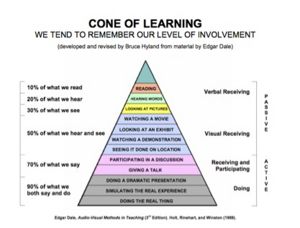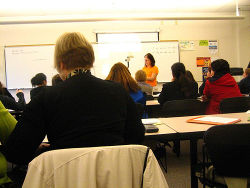My Sandbox 3
If you haven't opened this page in a separate tab you can get back to the original Gaining Foundation Skills page by clicking on the title in small coloured text above.
GFS Learning Module
This module introduces you (as an adult teacher/facilitator) to aspects of learning and learning styles.What is Learning?
.
Compare your thoughts with this dictionary definition:
Learning
"1. knowledge gained by study; instruction or scholarship
2. the act of gaining knowledge
3. (Psychology) Psychol any relatively permanent change in behaviour that occurs as a direct result of experience
Collins English Dictionary – Complete and Unabridged 6th Edition 2003. © William Collins Sons & Co. Ltd 1979, 1986 © HarperCollins
Publishers 1991, 1994, 1998, 2000, 2003
Retrieved on 28 January 2010 from: http://www.thefreedictionary.com/learning
teach
"(t ch) v. taught (tôt), teach·ing, teach·es v.tr.
1. To impart knowledge or skill to: teaches children.
2. To provide knowledge of; instruct in: teaches French.
3. To condition to a certain action or frame of mind: teaching youngsters to be self-reliant.
4. To cause to learn by example or experience: an accident that taught me a valuable lesson.
5. To advocate or preach: teaches racial and religious tolerance.
6. To carry on instruction on a regular basis in: taught high school for many years. v.intr. To give instruction, especially as an occupation.
The American Heritage® Dictionary of the English Language, Fourth Edition copyright ©2000 by Houghton Mifflin Company. Updated in
2009. Published by Houghton Mifflin Company. All rights reserved.
Retrieved on 28 January 2010 from:http://www.thefreedictionary.com/teach
"Today's adult educators recognize that it is no longer sufficient for teachers to teach and trainers to train. Rather than focus on information acquisition or behavior modification, they have expanded their efforts to emphasize the process of learning and its impact on adult development."
- Taylor, K., Marienau, C., & Fiddler, M.(2000). Developing Adult Learners: Strategies for Teachers and Trainers. California, Jossey-Bass Inc. (Cover flap)
- Taylor, K., Marienau, C., & Fiddler, M.(2000). Developing Adult Learners: Strategies for Teachers and Trainers. California, Jossey-Bass Inc. (Cover flap)
There has been a large shift in education from a focus on what is being taught by the teacher to a focus on the learner and what, why and how they are learning.
Even though the above quote is now 10 years old there are still many educators who focus solely on content.
Learning Approaches
In exploring adult learning there are several key factors to consider when thinking about how people learn and the ways in which they make meaning of information and experience. The first is the approach to learning. This can occur on different levels. The most significant being a deep learning approach compared to a surface learning approach.
Read this [summary of learning approaches](<- click on this link) and ponder the following questions:
|
Retaining what we learn
What is the best way to help us retain what we learn?
| Estimate the percentage (out of 100% for each) of the following:
We retain approximately
Compare your answers with that of a study by Edgar Dale and revised by Bruce Nyland
|
Passive learning occurs when information is being taken in but the learner does not necessarily understand, connect with or make meaning of the learning.
Active learning occurs when the learner makes a conscious connection with the learning in an effort to understand or make sense of the information or action. This may involve physical activity or simply ‘brain’ activity. Dale’s study suggests that if the learner has a passive involvement in their learning they are less likely to remember and retain new knowledge. The more active the involvement in learning the more the student gains from this.
This leads us to consider whether our teaching methods encourage active involvement for the learner.
It is important not to confuse active teaching with active learning. It is all about the level of engagement for the learner.
Click on the 'Bruce Nyland' link in the activity above to download a readable pdf version of this image.
Learning Styles
Whilst the section above gives us a general overview of how we retain learning it is important to remember that each learner is different. We all have our own preferences when it comes to learning that are influenced by the ways in which we think, our personalities, our backgrounds and our culture. In an attempt to capture and make sense of some of this, there are a large range of theories and models around learning styles and preferences. A popular model in the New Zealand context is the VARK – guide to learning styles. Neil Fleming has developed a tool to explore learning preferences that considers these in terms of the following modes of learning
- visual
- aural
- kinaesthetic
- reader/writer
Although they may have a preference, students will often utilise a variety of learning styles to enable their learning.
From a teaching perspective it is useful to be aware to students learning styles and make an effort to cater to a variety of these through using mixed teaching methods thus if teaching large numbers of students there is a greater opportunity to appeal to a wider range of learning styles.
If working with smaller numbers of students there is more opportunity to design teaching methods to better suit the needs of the smaller group.
*The way you define learning and teaching will shape the way in which you practice as an educator. How do you view yourself as a teacher/facilitator?
|
Further Reading and Links
For those that want to read further Learning Theory expands this exploration of learning.
This introduction to learning is built upon in the Learner Centred Learning course
To Do
1. Work through the Learning in context module.
2. Formally enrolled users then need to log into Moodle and go to the GFS course online discussion thread on Learning.
Links and Resources
(at a glance)
This is a repeat of the links and resources used in this weeks module to make it easier to access again later if you wish to. [Deep and Surface Learning]
VARK – guide to learning styles
Additional Resources
These are for those of you who may like to explore the topic further
Learner Centred Learning course
Surface Learning
- Learning to specifically meet course requirements
- Studying unrelated bits of knowledge
- Memorising facts and figures to repeat
- No linking or connection of learning
The surface approach to learning comes from “the intention to get the task out of the way with minimum trouble while appearing to meet course requirements” (Biggs, 2003, p14). This often includes rote learning content, filling an essay with detail rather than discussion and list points rather than providing background or context to the work.
Deep Learning
- Learning that seeks to understand and connect the concepts
- Relates ideas to previous knowledge and experience
- Explores links between evidence and conclusions
- Critiques arguments and examines rationale
The deep approach comes “from a felt need to engage the task appropriately and meaningfully, so the student tries to use the most appropriate cognitive activities for handling it” (Biggs, 2003, p16). Using this approach students make a real effort to connect with and understand what they are learning. This requires a strong base knowledge for students to then build on seeking both detailed information and trying to understand the bigger picture.
Strategic Learning
- Learning to achieve highest possible grades in a course
- Focused on assessment requirements and criteria
- Effort to understand knowledge to demonstrate learning
- Focused on perceived preferences of lecturer
Strategic learning, can be considered to be a balance between the other two approaches.
To ponder...
Some may place a negative connotation on surface learning whilst viewing deep learning in a more positive light but there is a place for surface learning to lay a base knowledge or terminology for deep learning to build on.
How do you view the approaches to learning in your own context?
Can you think of examples of where surface, deep and strategic learning occurs in your own context ?
Further Reading and Links
This is for those seeking more information, it is not core course material. Approaches to Study “Deep” and “Surface” - an easy to read site described by the author, James Atherton as a "quick and dirty" overview exploring deep and surface approaches to learning
Deep and Surface Approaches to Learning - a page from within The Higher Education Academy's UK website that provides another perspective and more information although it does take the crude viewpoint that "deep is good, surface is bad, and we should teach in a way that encourages students to adopt a deep approach; although achieving this is not so easy".
References
Biggs, J. (2003). Teaching for quality learning at University (2nd ed.). London: The Society for Research into Higher Education & Open University Press.





